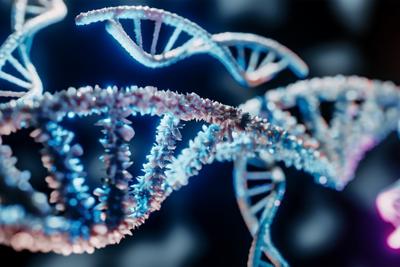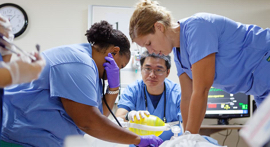
One of the big questions prospective MCAT-takers ask is whether genetics will be on the MCAT.
Yes, absolutely. There are two broad categories:
-
Transmission of genetic information from gene to protein.
-
Transmission of heritable information from generation to generation.
Transmission of Genetic Information from Gene to Protein
-
Chromosomes, DNA, and RNA
Know the structure and function of all these molecules! Don't forget centromeres, telomeres, supercoiling, heterochromatin, and euchromatin. -
Nucleotides and Base Pairing
Understand that G pairs with C and A pairs with T/U. -
DNA Replication
Be comfortable with the specific enzymes involved, semiconservative replication, the types of DNA mutations, the repair mechanism for mutations, and telomere replication. -
Central Dogma and the Genetic Code
Remember that DNA -> RNA -> protein. -
Transcription and mRNA Processing
Be aware of the process of transcription in detail (including the important enzymes) and how mRNA gets processed. You'll also want to know the different types of RNA: mRNA, tRNA, rRNA, hnRNA, siRNA, and miRNA. -
Translation and Post-Translation Modifications
Know the mechanism of translation in detail, the energy required for translation, ribosome structure, and any modifications that occur post-translationally. -
Control of Gene Expression
Be able to point out how mechanisms differ between prokaryotes (operon) and eukaryotes (repressors, enhancers, methylation, siRNA, and miRNA). -
Cancer
Know what cancer is and be able to differentiate between oncogenes and tumor suppressor genes. -
Recombinant DNA and Biotechnology
Be familiar with all the lab techniques you learned in your intro bio course: gel electrophoresis, cloning, restriction enzymes, cDNA libraries, expressing cloned genes, PCR, sequencing, Southern blotting, analyzing gene expression, and determining gene function.
Transmission of Heritable Information from Generation to Generation
-
Mendelian Genetics
Know the basic terms and how to apply them when doing both monohybrid and dihybrid crosses: dominant/recessive, genotype/phenotype, segregation/independent assortment, polymorphisms, homozygosity/heterozygosity, wild-type/mutant, and classical dominance. -
Non-Mendelian Genetics
Be familiar with incomplete dominance, codominance, sex-linked inheritance, test-crosses, back crosses, and hybrid viability. -
Meiosis vs. Mitosis
Understand the specifics of each process as well as the details of recombination and the concept of linked genes as well as mitochondrial inheritance. -
Hardy-Weinberg Principle
Know both equations. -
Recombination Frequency and Gene Mapping
Know the relationship between gene distance and recombination frequency (in case you need to make a gene map). -
Evolution
Be comfortable with natural selection, the concept of reproductive fitness, and speciation.
The Four Basic Single-Gene Crosses
- homozygote x same homozygote
- homozygous dominant x homozygous recessive
- homozygote x heterozygote
- heterozygote x heterozygote
The Two Rules of Probability
- rule of multiplication
- rule of addition
Pedigree Analysis Patterns
- identifying dominant vs. recessive
- identifying sex-linked vs. autosomal
- identifying mitochondrial vs. maternal inheritance
- Questions on genetics make up about 10% of the Biological and Biochemical Foundations of Living Systems section of the MCAT.
- You can expect 5–6 questions centered on the above topics.
- Questions on the transmission of genetic information from gene to protein (e.g., DNA and RNA structure and function—replication, transcription, and translation) tend to be presented as complete passages.
- Questions on the transmission of heritable information from generation to generation (e.g., genetics probability, linkage, Hardy-Weinberg), tend to show up more as freestanding questions or individual questions tucked into a passage.
Getting one or two additional questions right can help boost your MCAT score. Even if genetics is not your favorite topic, it's worth practicing so that you can answer these types of questions correctly and quickly.
Here's some MCAT genetics practice for you:
1. Which of the following is NOT true of euchromatin?
(A) It is typically a site of active transcription.
(B) It typically has a lower lysine-acetylation rate than heterochromatin.
(C) It has a less compact structure than heterochromatin.
(D) It disappears during mitosis.
Answer: (B)
Euchromatin is a region of the chromosome that is less tightly wound around histone proteins and thus has a less compact appearance than heterochromatin (choice C is true and can be eliminated). These are typically areas where active transcription is occurring (choice A is true and can be eliminated), but disappear during mitosis, when the chromosomes condense tightly in preparation for cell division (choice D is true and can be eliminated). The looser structure is due to the acetylation of the histone proteins at lysine residues; the binding of the acetyl group neutralizes the positive charge of the lysine and disrupts its binding to the negatively charged phosphate groups on DNA. Euchromatin thus typically has a higher lysine-acetylation rate compared to heterochromatin (choice B is false and the correct answer choice).
2. Huntington's disease is an autosomal dominant disorder; the affected gene is found on chromosome 4. Marfan syndrome, another autosomal dominant disorder, is caused by a defective allele on chromosome 15. A woman heterozygous for Huntington's disease and Marfan syndrome has children with a man who is normal with respect to those two diseases. What is the probability they would have a child afflicted with either Huntington's disease or Marfan syndrome?
(A) 1/8
(B) 1/4
(C) 1/2
(D) 3/4
Answer: (D)
Since the genes causing these two disorders are found on completely different chromosomes, they are unlinked; you can consider each condition independently of the other, then combine the results using the rules of probability. The woman is described as heterozygous for both disorders ( HhMm ), and the man is described as normal. In order to be normal with respect to a dominant disorder, you must be homozygous recessive, as even a single copy of the dominant allele will lead to disease expression. Therefore, the man's genotype is hhmm , and he can only pass h and m to his offspring. The woman has a 1/2 probability of passing on H and a 1/2 probability of passing on M , so there is a 1/2 probability of a child inheriting Huntington's disease, and a 1/2 probability of a child inheriting Marfan syndrome. The question asks for the probability of a child afflicted with either Huntington's disease OR Marfan syndrome, so use the rule of addition: P (A or B) = P (A) + P (B) – P (A and B) = 1/2 + 1/2 – (1/2 x 1/2) = 1 – 1/4 = 3/4.
Explore Graduate Programs for You
Explore our featured graduate schools & programs to find those that both match your interests and are looking for students like you.
Best Law Schools
Check out our complete list of 168 law schools, based on surveys of school administrators and over 17,000 students.
Search for Medical Schools
Visit our Med School Hub to explore med schools with our ‘Find Your Med School’ filtered search or visit our Med School Advice pages for info about good MCAT scores or interview question prep.

Find MBA Programs Matched to Your Interests
Explore our featured business schools to find those that are looking for students like you.
Explore Graduate Programs for You
Explore our featured graduate schools & programs to find those that both match your interests and are looking for students like you.
Best Law Schools
Check out our complete list of 168 law schools, based on surveys of school administrators and over 17,000 students.
Search for Medical Schools
Visit our Med School Hub to explore med schools with our ‘Find Your Med School’ filtered search or visit our Med School Advice pages for info about good MCAT scores or interview question prep.

Find MBA Programs Matched to Your Interests
Explore our featured business schools to find those that are looking for students like you.
Explore Graduate Programs for You
Explore our featured graduate schools & programs to find those that both match your interests and are looking for students like you.
Best Law Schools
Check out our complete list of 168 law schools, based on surveys of school administrators and over 17,000 students.
Search for Medical Schools
Visit our Med School Hub to explore med schools with our ‘Find Your Med School’ filtered search or visit our Med School Advice pages for info about good MCAT scores or interview question prep.

Find MBA Programs Matched to Your Interests
Explore our featured business schools to find those that are looking for students like you.


